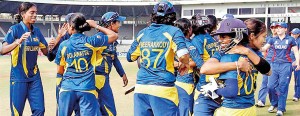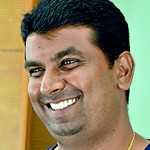Harsha – the man in the women’s world
View(s):Guiding the women to play a man’s game
By Naushad Amit

Lankan lasses celebrate their inaugural World Cup victory against England.
If you take honest look inwards, you will admit that until the year 2013 you did not take Sri Lankan women’s cricket seriously. Yes, the game has been on this soil for the last few decades, but the focus and attention paid to it was scant. Yet, there was a person who believed in his abilities, and at the same time he also believed that the abilities of the Lankan women cricketers could be converted into runs and wickets. The Lankan women’s coach Harsha de Silva is now a real man in a woman’s world.
The ICC Women’s World Cup 2013 ended in India a week ago with Australia clinching the championship for the sixth occasion but the world certainly saw how teams like Sri Lanka and West Indies paced during the competition. When the Sri Lanka women cricketers snatched unlikely yet historic wins against high-riding England, India and New Zealand much were talked about and debated back in Sri Lanka; even by going to the extent of comparing them with their male counterparts.
But Coach de Silva thinks it’s too premature and unfair to compare women’s cricket or his team, an improving outfit in the world, to the superior gender in the game, the men. De Silva probably went through the toughest transformation in his career. He was good at coaching a successful boy’s team at St Joseph’s. Then he was handed over the challenge of changing a worn out and lacklustre Sri Lanka women’s team to a winning outfit. In three years he has proved what motivation could really do. But he feels that the local girls will have to strive more to earn what the men did in the world circuit.

Harsha de Silva
“Men’s cricket is where it is today thanks to all the efforts of former and present cricketers. The men became world champions and entered many finals at ICC World Championships. We can’t, at the moment compare women and men cricket as men’s cricket whether we like or not is number one in Sri Lanka. It’s not fair comparing the brand of cricket that these two genders produce. The Sri Lanka men’s team have already earned that status and the girls have to work hard to earn it. It’s a long journey ahead and we just became the fifth best women’s team in the world. It’s just the beginning. This we can consider as the first step of a long road ahead” opined de Silva in an exclusive interview with the Sunday Times.
Harsha’s talents as a cricket coach depicted while he was handling the Josephian cricketers. Cricketers who were sieved through came in the calibre of Angelo Mathews, Thisara Perera, Dimuth Karunaratne, Roshen Silva and many others to reach the main stream while many of his close associates discouraged him from taking up a daunting assignment like the women’s team. But an optimistic de Silva as an internationally qualified coach may have felt otherwise. His approach of coaching the Sri Lanka women’s cricket team, a side that had not learned the art of winning and being consistent.
Among the many surprises he had for the girls were – statistical observations, making use of previous performances and assessments and the true need of changing the girls’ thinking pattern on planning a game, which were in a way totally new to them. According to de Silva there were certain areas that he had to focus more besides brushing up the talent and potential. He even introduced a mentor to improve the mental attitude of the girls and even recruited a yoga instructor to help them overcome what the girls thought unconquerable. “These practices really paid off in a way. There was a clear improvement among the girls. They were more serious in what they did and it was a really painless process from there onwards.”
With his previous experiences as a coach and working closely for three years before the ICC Women’s World Cup 2013, de Silva gradually stepped into working closely in stepping up their individual skills.
“We found out that the girls were not keen to in rotating the strike. That was inculcated into them. In addition statistics showed that they failed to use gaps of the field when batting and even misused power-hitting opportunities. It was after identifying the potentials that we decided to slot players at suitable spots in the batting order. We also had do some changes to the existing team. When we reached India for the world cup we relied much on skipper Sashikala Siriwardene as the top allrounder and Chamari Atapattu as a consistent batter.”
“But with these new discoveries we unearthed the true potentials in players like Eshani Kaushalya, Deepika Rasangika, Chamani Seneviratne and the young Yasoda Mendis who came out well and helped the team win games. Eventually we progressed from number eight, losing all games in the previous world cup, to make winning a habit and end up as number five in the world in three years. It’s a major step forward for women’s cricket in Sri Lanka and the girls are keen to maintain the status,” he added.
However one of the key setbacks that were observed during the concluded championship was the inconsistency. They snatch a thrilling 1-wicket win against former world champions England in their first match and get thrashed by a massive margin of 209 runs from eventual runners-up West Indies in their second game. Then the Sri Lankan girls send shockwaves by defeating the much improved Indian outfit by 138 runs and reaching the Super Six stage and they lost to New Zealand by 8 wickets. This followed with defeats against Australia and South Africa. Eventually they beat South Africans by 88 runs in the fifth place play-off.”
De Silva while accepting the lapse of consistency observed the need of giving the girls more opportunities to play at international level so they could learn from their mistakes, fix up and assemble as a strong unit to be world beaters in time to come.
With these developments more international teams have shown interest to play against Sri Lanka which is a healthy state for women’s cricket at a time when the whole of Sri Lanka was able to witness what girls could do in cricket. At the same time a lot of young girls have shown interest to take up women’s cricket after what Sri Lanka achieved in India. It will be a matter of days before the Sri Lanka Schools Cricket Association unveils an Under-19 cricket tournament among girls’ schools and de Silva positively thinks that it is the way forward to develop the game by letting the young girls play cricket at a very tender age. De Silva thinks if not women’s cricket will always remain where it is, below par.
Follow @timesonlinelk
comments powered by Disqus

















